![Russell Thomas as Hoffmann and Lauren Segal as The Muse/Nicklausse in The Tales of Hoffmann [Photo by Michael Cooper courtesy of the Canadian Opera Company]](http://www.operatoday.com/hoffmann417.png)
04 Jun 2012
A Toronto Trilogy
Canadian Opera Company’s diverse May offerings included some superlatively sung Handel, a galvanizing star turn from a rising tenor talent, and a well-matched veristic double bill of tragedy and comedy.
English Touring Opera are delighted to announce a season of lyric monodramas to tour nationally from October to December. The season features music for solo singer and piano by Argento, Britten, Tippett and Shostakovich with a bold and inventive approach to making opera during social distancing.
This tenth of ten Live from London concerts was in fact a recorded live performance from California. It was no less enjoyable for that, and it was also uplifting to learn that this wasn’t in fact the ‘last’ LfL event that we will be able to enjoy, courtesy of VOCES8 and their fellow vocal ensembles (more below …).
Ever since Wigmore Hall announced their superb series of autumn concerts, all streamed live and available free of charge, I’d been looking forward to this song recital by Ian Bostridge and Imogen Cooper.
Although Stile Antico’s programme article for their Live from London recital introduced their selection from the many treasures of the English Renaissance in the context of the theological debates and upheavals of the Tudor and Elizabethan years, their performance was more evocative of private chamber music than of public liturgy.
Evidently, face masks don’t stifle appreciative “Bravo!”s. And, reducing audience numbers doesn’t lower the volume of such acclamations. For, the audience at Wigmore Hall gave soprano Elizabeth Llewellyn and pianist Simon Lepper a greatly deserved warm reception and hearty response following this lunchtime recital of late-Romantic song.
For this week’s Live from London vocal recital we moved from the home of VOCES8, St Anne and St Agnes in the City of London, to Kings Place, where The Sixteen - who have been associate artists at the venue for some time - presented a programme of music and words bound together by the theme of ‘reflection’.
'Such is your divine Disposation that both you excellently understand, and royally entertaine the Exercise of Musicke.’
‘And there was war in heaven: Michael and his angels fought against the dragon; and the dragon fought and his angels, And prevailed not; neither was their place found any more in heaven … that old serpent … Satan, which deceiveth the whole world: he was cast out into the earth, and his angels were cast out with him.’
There was never any doubt that the fifth of the twelve Met Stars Live in Concert broadcasts was going to be a palpably intense and vivid event, as well as a musically stunning and theatrically enervating experience.
‘Love’ was the theme for this Live from London performance by Apollo5. Given the complexity and diversity of that human emotion, and Apollo5’s reputation for versatility and diverse repertoire, ranging from Renaissance choral music to jazz, from contemporary classical works to popular song, it was no surprise that their programme spanned 500 years and several musical styles.
The Academy of St Martin in the Fields have titled their autumn series of eight concerts - which are taking place at 5pm and 7.30pm on two Saturdays each month at their home venue in Trafalgar Square, and being filmed for streaming the following Thursday - ‘re:connect’.
The London Symphony Orchestra opened their Autumn 2020 season with a homage to Oliver Knussen, who died at the age of 66 in July 2018. The programme traced a national musical lineage through the twentieth century, from Britten to Knussen, on to Mark-Anthony Turnage, and entwining the LSO and Rattle too.
With the Live from London digital vocal festival entering the second half of the series, the festival’s host, VOCES8, returned to their home at St Annes and St Agnes in the City of London to present a sequence of ‘Choral Dances’ - vocal music inspired by dance, embracing diverse genres from the Renaissance madrigal to swing jazz.
Just a few unison string wriggles from the opening of Mozart’s overture to Le nozze di Figaro are enough to make any opera-lover perch on the edge of their seat, in excited anticipation of the drama in music to come, so there could be no other curtain-raiser for this Gala Concert at the Royal Opera House, the latest instalment from ‘their House’ to ‘our houses’.
"Before the ending of the day, creator of all things, we pray that, with your accustomed mercy, you may watch over us."
The doors at The Metropolitan Opera will not open to live audiences until 2021 at the earliest, and the likelihood of normal operatic life resuming in cities around the world looks but a distant dream at present. But, while we may not be invited from our homes into the opera house for some time yet, with its free daily screenings of past productions and its pay-per-view Met Stars Live in Concert series, the Met continues to bring opera into our homes.
Music-making at this year’s Grange Festival Opera may have fallen silent in June and July, but the country house and extensive grounds of The Grange provided an ideal setting for a weekend of twelve specially conceived ‘promenade’ performances encompassing music and dance.
There’s a “slide of harmony” and “all the bones leave your body at that moment and you collapse to the floor, it’s so extraordinary.”
“Music for a while, shall all your cares beguile.”
The hum of bees rising from myriad scented blooms; gentle strains of birdsong; the cheerful chatter of picnickers beside a still lake; decorous thwacks of leather on willow; song and music floating through the warm evening air.
![Russell Thomas as Hoffmann and Lauren Segal as The Muse/Nicklausse in The Tales of Hoffmann [Photo by Michael Cooper courtesy of the Canadian Opera Company]](http://www.operatoday.com/hoffmann417.png)
Canadian Opera Company’s diverse May offerings included some superlatively sung Handel, a galvanizing star turn from a rising tenor talent, and a well-matched veristic double bill of tragedy and comedy.
Dazzling vocalism ensured constant musical delight in the company’s Semele, an oratorio-turned-opera that has been getting wider play on world stages as more and more singers appear who can actually meet the score’s interpretive demands.
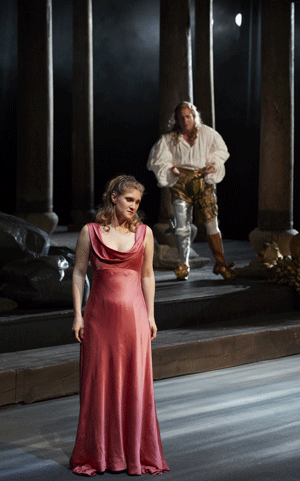 Jane Archibald as Semele (foreground) and William Burden as Jupiter (background) in Semele
Jane Archibald as Semele (foreground) and William Burden as Jupiter (background) in Semele
Jane Archibald surely has few (any?) equals in the title role, her plush silvery soprano filling the house with a vibrant presence. Hers is one of the most assured techniques in the business, and she tossed of the coloratura of “Myself I shall adore” with utter confidence and great tonal beauty. The jaw-dropping accuracy and breath-taking rapidity of the (almost non-stop) melismas did not seem intended to be heard merely by mortal ears. But Ms. Archibald was much more that flash and dazzle. Her sonorous, limpid treatment of Handel’s legato phrases was no less impressive.
Moreover, as an actress, Jane is a total natural, her movement fluid and spontaneous, her gestures motivated and meaningful, her interaction with fellow characters committed and collegial. The fact that she flawlessly intoned her first famous aria while being flown like an angel figure, descending from the flies and hovering twenty feet above the stage, is nothing short of miraculously concentrated artistry. A lovely physical presence married to first-tier artistry, Jane Archibald can likely write her operatic future as she pleases.
Allyson McHardy was also a potent force with which Semele has to reckon, in her dual roles of Ino and Juno. Her pliable, plummy mezzo was not only cleanly and evenly produced, but Ms. McHardy was able to damn’ near match the heroine’s vocal pyrotechnics, as evidenced by a riveting, hair-raising account of “Hence, hence, Iris, hence away.” If Allyson had brought any more blazingly accurate intensity to this aria, I am not sure my heart could have stood it!
The reliable, chameleon-like William Burden turned in yet another memorable, finely tuned, beautifully judged performance as Jupiter. This fine tenor is so effortlessly terrific in such a wide variety of roles and genres, that it could be easy to take him for granted. As usual, he does not disappoint, treating us to superbly controlled, meaningfully phrased Handel that is invested with emotional import, freely produced tone, and meticulous diction. His hushed, languid Where’er you walk was alone worth the priced of admission. And William-the-Handsome certainly has the physique du rôle to impersonate any super hero he wants.
The role of Athamas is assumed by highly skilled counter-tenor Anthony Roth Costanzo, who impresses me even more every time I hear him. His easy projection and skillful florid singing were knitted to a forward-placed tone of considerable power and color. Mr. Costanzo has a special gift for blending descents to lower notes into a potent, almost baritonal timbre that pays good interpretive dividends. Steven Humes was quite winning in the dual assigment as Cadmus and Somnus. His orotund bass had a decent bite to the sound, and he showed off some powerful excursions into a sustained deep register that suggested penetrating pedal tones on a pipe organ. Impressive.
Rinaldo Alessandrini showed a sure hand leading the period instrument group in the pit and the players responded with secure, supportive playing which ably partnered the singers. I have heard more color, personality, and dramatic fire from other well-established early music groups, but nonetheless, this band was clean, and responsive. The choral singing under Sandra Horst was a marvel of style and tonal beauty.
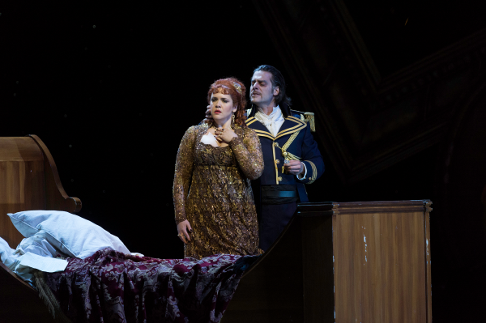 Keri Alkema as Giulietta and John Relyea as Dapertutto in The Tales of Hoffmann
Keri Alkema as Giulietta and John Relyea as Dapertutto in The Tales of Hoffmann
In press releases, director Zhang Huan remarked to the effect that he had never directed an opera. The quick and dirty reaction would be: “He still hasn’t.” But that would be to deny many beautiful visual elements of the production, the scenery of which he also designed. Or rather, re-assembled. For the basic environment was an actual Chinese temple, that the artist purchased, shipped, and put back together on the stage at the Fours Seasons Center. A mini-documentary (grainy black and white with subtitles) of the acquisition process is projected during the overture, unfortunately thereby relegating the score to Muzak. But it must be reported that when the curtain rose to reveal the actual temple filling the stage, the audience burst into applause (as much for effort as for artistry). But it did not really wear well as the show went on.
For Mr. Huan, there was evidently some spiritual impetus, some mystic force that this structure was meant to conjure. For me, the set could have been built out of Canadian lumber and styrofoam, and the whole lovingly painted with fine detail and texture, and COC would have been spared a whole lot of bother. Lest that seem irreverent of me, Zhang himself had little trouble disrespecting Handel’s creation as he pursued extra-musical distractions that were shoe-horned into this Buddhism-inspired interpretation. A colorful, randy donkey (two dancers) wears out its visual welcome in the first scene. Did Athanas really have to stroke the ass’s ass at the end of his impeccably sung aria? And then the damn’ animal re-appears later during choral revelry sporting a huge, latex erection, intent on impaling some-one/thing with it.
And hey, did you ever think Handel and Sumo wrestlers were a ‘match’? I can report the sound of naked chubby flesh slapping together was not an enhancement to the score. (In this version, “it ain’t over ‘til the fat man wrestles.”) The insertion of an Asian unaccompanied song, a nasal tenor solo regaling us with meanderings and wailings (perhaps well-sung by Asian folk song standards?) again completely took us out of the musical style. And this after cutting Semele’s “The Morning Lark!” Oh, and the last joyous chorus was also MIA. Yes, that’s right. The show ended as it began, with a peasant woman sweeping the floor with a twig broom as the persistent sound of rainfall slowly faded and the curtain slowly fell. Sorry, but I have to ask: where was the Music Director during all this? As compensation, a recording of the final chorus was piped into the lobby as we left the theatre. All of this had as much to do with Semele as well, the price of tea in China. Contrary to the advertisements, this piece is not Zhang Huan’s Semele. To have allowed it to be so did Handel an enormous disservice.
To be fair, some effects landed. Having Somnus atop the roof as a giant doll that inflates as he awakes, with a mini-Somnus singing for, and in front of the blow-up was good fun. I guess the sinuous parading dragon suited the chaotic moment in which it was interpolated. Best of all, having Jupiter lovingly bathe Semele’s feet while he intoned “Where e’er…” was a stunning visual depiction, a brief oasis of truth in the theatrical muddle. At least the stellar cast was placed, often down stage to be heard to maximum advantage. Han Feng designed gorgeous costumes, eye-catching and character specific, a quirky-but-worky blend of traditional Asian, Baroque, and modern accents that were endlessly appealing (Juno’s wig seemed a paean to Marge Simpson). Wolfgang Goebbel’s lighting design (recreated by Willem Laarman) was by turns haunting and vibrant. There may be a case to be made for the parallels between ancient Chinese deities and those that people Semele, but this production has not yet found a cogent realization.
On the other hand, the next night’s The Tales of Hoffmann was arguably my favorite staging to date of this enigmatic masterpiece, which seems to have as many different performing editions as there are different productions. The total success of this mounting started with the remarkably assured performance from young American tenor Russell Thomas in the title role. Mr. Thomas has an uncommonly attractive, unforced instrument that is evenly produced from top to bottom. The tone is meaty enough to be (just) on the brink of verismo success, but never pushed past its limit. Its thrilling clarion punch in the upper reaches is complemented by his total skill at seamlessly scaling back a held high note from forte to piano, with no loss in presence or quality.
Too, Russell displays considerable skill at investing words and phrases with appropriate emotional content and nuance to not only propel the story, but also to limn Hoffmann’s mercurial nature. This is already a major talent. If he continues to grow at a measured pace, exercises good judgment in repertoire, and keeps the voice flowing as beautifully free as in its current estate, Russell Brown could become that elusive new superstar tenor (read: Verdi and Puccini) the world has been waiting for.
Hard to believe that home boy John Relyea was making his Canadian Opera Company debut with the four villains. Already a long established, acclaimed singer at all of the world’s major houses, Mr. Relyea confirmed the reason for his stature with an assured performance of power and polish. There is virtually nothing in these four diabolical characters that eludes him. His rolling bass is handsome, dark, and pointed, with such a well-focussed projection that it could probably be heard in Niagara Falls. For a sound this big and imposing, Mr. Relyea displayed considerable flexibility, and he certainly knows how to make each phrase count. When a phrase or two ventured into the extreme upper register, he got through it with moxie and a bit of covering, but this is a pro who knows how to engage an audience with exuberant vocalism. (I did wonder how he might fare with the suave demands of “Scintille, diamant,” cut from this edition.)
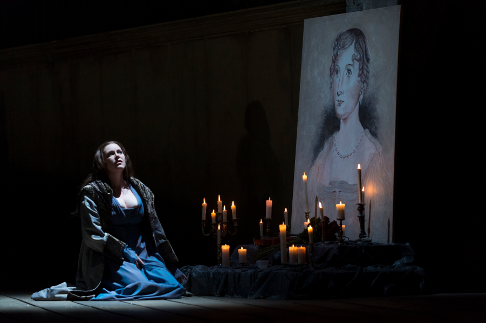 Erin Wall as Antonia
Erin Wall as Antonia
The women were also ideally cast, starting with audience favorite Andriana Chuchman as Olympia. The petite soprano, lithe of figure and lovely to behold, spun out a glittering filigree of ornamentation, staccati and arpeggiated figures. Her physical embodiment of the emotionally vacant automaton communicated volumes and was admirably consistent. Her lean, fluty timbre was well projected and securely produced, but a little attention to tuning might be suggested in the extended outline of several of the broken chords. Nonetheless the audience was giddy with delight at Ms. Chuchman’s solid work.
Erin Wall proved to be a near ideal Antonia, sporting a ripe middle range and gleaming top notes. The warm shading in Ms. Wall’s well-schooled soprano was a match made in heaven for the doomed girl’s characterization, and her masterful way with shaping extended phrases of arching beauty was revelatory. A sincere and involved actress, Erin elicited our complete sympathy as she took Antonia’s melancholy journey. Keri Alkema lavished Giulettia with a dusky, sonorous mezzo that made a persuasive case for this (to me) least complex heroine of the piece. Her mellow, surging rendition of the famous Barcarolle was one the evening’s highlights.
Lauren Segal was exceedingly fine doing double duty as the Muse and Nicklausse. Ms. Segal always put her gleaming, sturdy instrument to good artistic purpose, delineating well between the two personages, and investing both with secure musicality. Steven Cole contributed four incredibly inventive, appealingly sung comprimario turns as Andres, Cochenille, Frantz, and Pitichinaccio. In fact, I have never seen anyone do these better, making Mr. Cole a wonderful ‘discovery.’ The incredible depth of this cast went on to include a ringing Luther from Valerian Ruminski; a sturdy performance from Gregory Dahl, effectively doubled as Crespel and Schlémil; a well-realized Spalanzani from Michael Barrett; and high spirited portrayals by two promising, fresh-voiced young singers Christopher Enns (Nathanael) and Philippe Sly (Hermann). The Voice of Antonia’s Mother featured young Ileana Montalbetti whose luxuriant singing brought a radiant sheen to the proceedings.
Johannes Debus elicited luminous results from his orchestra, which gifted us with playing that was stylistically thrilling and dramatically involved. Maestro Debus crafted a well integrated musical effect, knitting Offenbach’s diverse components into an immensely satisfying experience. Director Lee Blakeley and Set Designer Roni Toren successfully conspired to showcase all this musical brilliance in a production that was aptly fantastical, starting us off in Stella’s tilted, cramped and skewed dressing room.
We see the diva (excellently portrayed by Ambur Braid) preparing to go onstage, as the brooding, imbibing Hoffmann alternatively writes, lurches, and confronts her in the confined quarters. Soon after her departure, other characters invade the space entering from hither and yon like a bad dream. By the time Lindorf crawls out from inside the bed the chimerical nature of the piece was wonderfully well established.
Subsequent acts take place in a sort of generic, musty, great hall, with Stella’s portrait omnipresent. The hall gets re-dressed with a demented mix of ‘normal’ and over-sized set pieces. Within this environment, the imagination of the interpreters never wanes. For example, a covering is removed to reveal Olympia in a glass coffin, like Snow White. Once she is assisted out of it and united with her harp for the aria, a madcap ‘generator’ is rolled on and the doll is hooked up to electrodes. Every time she ‘winds down’ or goes amuck, she is shocked back to life with a burst of sparks. For the opening tavern scene the choristers came exploding through the dressing room and spilled onto the stage in a high energy visual and musical assault. I quite liked the large bed-as-boat that informed the Giulietta act. And returning to the cramped dressing room for the epilogue book-ended the piece marvelously, with the Muse now appearing on the roof, gazing down through the hole in the ceiling as Stella, having toyed with idea of pairing with Lindorf, rejects him and comes back to the dressing room as a final ‘surprise.’
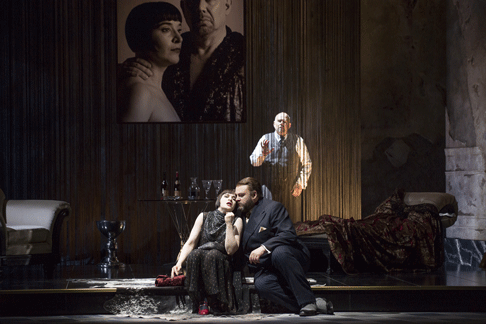 (l - r) Gun-Brit Barkmin as Bianca, Michael König as Guido Bardi and Alan Held as Simone (background) in A Florentine Tragedy
(l - r) Gun-Brit Barkmin as Bianca, Michael König as Guido Bardi and Alan Held as Simone (background) in A Florentine Tragedy
Only the enormous easy chair, in which Antonia is made to sit, did not ring true. The sight recalled to me Lily Tomlin’s Edith Ann, Laugh In’s bratty little girl in the oversize chair. Perhaps I have lived too long, but that imagery lingered in the back of my mind every time the doomed Antonia scrambled back onto her perch. Still, considering the immensely satisfying overall achievements, not least of which was terrific character development and interaction, I will concede that this was a brilliantly realized vision.
Sharing in this success, Costume Designer Brigitte Reiffenstuel has embraced the concept and devised enormously appealing attire, at times authentically period, at others mere flights of fancy. Jenny Cane’s lighting design was appropriately moody and mysterious, but straight forward when required. Sandra Horst’s choral direction was again a significant contribution. The Tales of Hoffmann was one of those cherishable experiences that not only immediately entertained and touched me, but also has given me reason for reflection days after.
Noted soprano Catherine Malfitano has turned her attention to directing in recent years, and a career’s worth of performing insights `has stood her in good stead as she tackled the double bill of A Florentine Tragedy and Gianni Schicchi. I find the former to be a complex work, musically stimulating, but dramatically flawed. The wife’s flirting and seduction of her lover which becomes more and more blatant in front of the cuckolded husband, is hard to bring off convincingly. For her part, Ms. Malfitano seems to have borrowed a bit of unhinged obsession from Paul Shrader’s The Comfort of Strangers. In that art film, an older couple conceal a whole lotta ‘kink’ as the seem to befriend a younger couple, but are actually stalking them. In the denouement the older man kills the younger man, which induces a bizarre sexual gratification to the older pair.
In the opera at hand, there were suggestions of that kind of menace from the start. Is this a recurring game the married couple plays out? Is it a three way, waiting to happen? Or is it on face value, a simple affair that goes wrong with no pre-meditation? Our director has raised these intriguing questions, but contents herself to stay on the fringes of any committed point of view. The three singers seemed game enough, but half-hearted gestures seemed stunted and faux-salacious. A pair that has done the illicit deed certainly should behave with more physical abandon and seething passion than Gun-Brit Barkmin (Bianca) andMichael König (Guido Bardi) were able to communicate.
Ms. Barkmin has a substantial soprano, and occasionally it soared incisively over the orchestra. Mr. König worked diligently and sang intelligently. But the two were not able to suggest any sexual chemistry, and their vocal presence seemed curiously muted. I just had the feeling that Zemlinksy’s writing for these roles was not an optimum match for their particular vocal gifts. Both have impressive credits, so I would look forward to hearing them again in roles that might offer more grateful pairings.
Alan Held, on the other hand, was up to every interpretive demand of the wronged husband Simone. This seasoned performer commands a plush bass-baritone of enormous fire power. Mr. Held is not only able to summon up fierce indignation for the confrontational outbursts, but he is also exceptionally capable of conveying controlled, simmering menace that is positively chills-inducing. The evening seems to have been intended to showcase his substantial gifts. After putting us through the Tragedy wringer, Alan effortlessly turned on a dime and won our hearts (and funny bones) with as roguishly enchanting a Schicchi as we could be desire.
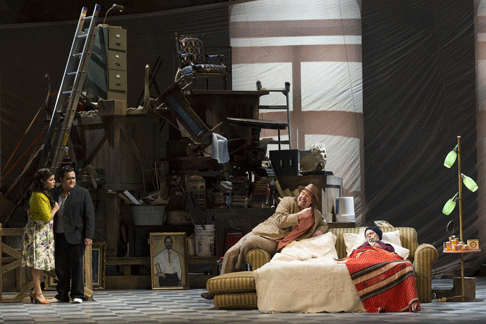 (l - r) Simone Osborne as Lauretta, René Barbera as Rinuccio and Alan Held as Gianni Schicchi in Gianni Schicchi
(l - r) Simone Osborne as Lauretta, René Barbera as Rinuccio and Alan Held as Gianni Schicchi in Gianni Schicchi
Sharing equal above-the-title(s) star billing, Sir Andrew Davis had a brilliant night conducting as well, first discovering the wealth of ripe orchestral detail with a rhapsodic reading of the Zemlinksy. Maestro Davis proved a sensitive and diligent collaborator with his soloists, surging the music with abandon whenever possible, but pulling back to provide a comfortable cushion of an accompaniment on others. And he did something with the Puccini I did not think possible. He made it seem new again, and together with COC’s outstanding orchestra, they invested the well-known chestnut with spontaneity, inevitability, and a real sense of delicious discovery.
Both productions shared some common design elements. Wilson Chin devised a suitably threatening environment for the tragedy. An upstage wall features a stage left opening fronted by a silvery bead curtain, and a stage right opening that serves as a cavernous black hole from which the suspicious husband make his portentous entrance. A huge photo of the man and wife looms over the indiscreet trysting. A scattering of art nouveau furniture defines the living room. A curious (and under used) rusting spiral staircase sits far right, ascending up into the flies. All of this murky vaguery was an effective complement to the plot twists and turns. Terese Wadden designed the efficient, formal costumes, and David Martin Jacques manages the tricky feat of balancing atmospheric shadowy effects with ample illumination of the performers’ faces.
Then for the comedy, the team makes a wholly successful about face and gives us a look that is all Italian sunlight, vivaciously colorful costumes, and a set that includes, among other things, a huge pile of furniture, appliances, and collectibles that are ready to be parceled out to Buoso’s survivors. Ms. Malfitano was in full command of the stagecraft here, and created lively business, logical blocking, and well-defined individual characters. She showed especial skill at creating unison reactions (such as everyone taking in and then holding their breath together) that were entertaining without ever wearing out their welcome. Another favorite bit: at curtain rise all the men are crowded around the television watching a soccer match, but blocking it from Buoso’s view. He is very much alive and interested in the game, until the men react with loud disappointment to the final score, which apparently displeases Buoso so much that. . .he drops dead. The poor corpse is on a sofa bed, in which he unceremoniously gets folded up to hide the body!
With the marvelous Alan Held to anchor the show, the rest of the cast rose to his level. Simone Osborne was a delectable Lauretta, imbuing her thrice-famous aria with individualized personality, superior legato, and melting tone. The ovation for “O mio babbino caro” was prolonged and well-deserved. René Barbera as Rinuccio was a perfect match for her, and he exuded cherubic charm and sang joyously with a radiantly youthful lyric tenor.
The scheming relatives were well-cast, led by Barbara Dever, whose commanding presence and imposing voice made for a very well drawn Zita. Gun-Brit Barkmin was the other hold-over from the first show, and she treated us to a spunky Nella. Donato di Stefano made the most of his every moment as the ‘eldest’ Simone; Adam Luther was a marvel of comic invention as the blithering Gherardo; Craig Irvine was a dynamically scheming Betto di Signa; Peter McGillivray, a befuddled Marco; Rihab Chaieb contributed a glam and sassy La Ciesca; and Gabriel Gough offered an energetic Gherardino.
By opera’s end when Rinuccio pulls down a cloth that had blocked the windows, revealing the skyline of Florence in all its glory, we were already basking in the glow of a perfectly calibrated Gianni Schicchi.
James Sohre
Semele
Cadmus/Somnus: Steven Humes; Athamas: Anthony Roth Costanzo; Semele: Jane Archibald; Ino/Juno: Allyson McHardy; Iris: Katherine Whyte; Jupiter: William Burden; Conductor: Rinaldo Alessandrini; Director and Set Design: Zhang Huan; Costume Design: Han Feng; Lighting Design: Wolfgang Goebbel; Lighting Design Recreation: Willem Laarman; Chorus Master: Sandra Horst
The Tales of Hoffmann
Muse/Nicklausse: Lauren Segal; Lindorf/Coppelius/Dr. Miracle/Dapertutto: John Relyea; Andres/Cochenille/Frantz/Pitichinaccio: Steven Cole; Luther: Valerian Ruminski; Nathanael: Christopher Enns; Hermann: Philippe Sly; Hoffmann: Russell Thomas; Spalanzani: Michael Barrett; Olympia: Andriana Chuchman; Antonia: Erin Wall; Crespel/Schlémil: Gregory Dahl; Voice of Antonia’s Mother: Ileana Montalbetti; Giulietta: Keri Alkema; Stella: Ambur Braid; Conductor: Johannes Debus; Director: Lee Blakeley; Set Design: Roni Toren; Costume Design: Brigitte Reiffenstuel; Lighting Design: Jenny Cane; Chorus Master: Sandra Horst
A Florentine Tragedy
Simone: Alan Held; Bianca: Gun-Brit Barkmin; Guido Bardi: Michael König; Conductor: Sir Andrew Davis; Director: Catherine Malfitano; Set Design: Wilson Chin; Costume Design: Terese Wadden; Lighting Design: David Martin Jacques
Gianni Schicchi
Gianni Schicchi: Alan Held; Lauretta: Simone Osborne; Zita: Barbara Dever; Rinuccio: René Barbera; Gherardo: Adam Luther; Nella: Gun-Brit Barkmin; Betto di Signa: Craig Irvine; Simone: Donato DiStefano; Marco: Peter McGillivray; La Ciesca: Rihab Chaieb; Gherardino: Gabriel Gough; Maestro Spinelloccio: Doug McNaughton; Ser Amantio di Nicolao: Philippe Sly; Pinellino: Neil Craighead; Guccio: Valerian Ruminski; Conductor: Sir Andrew Davis; Director: Catherine Malfitano; Set Design: Wilson Chin; Costume Design: Terese Wadden; Lighting Design: David Martin Jacques